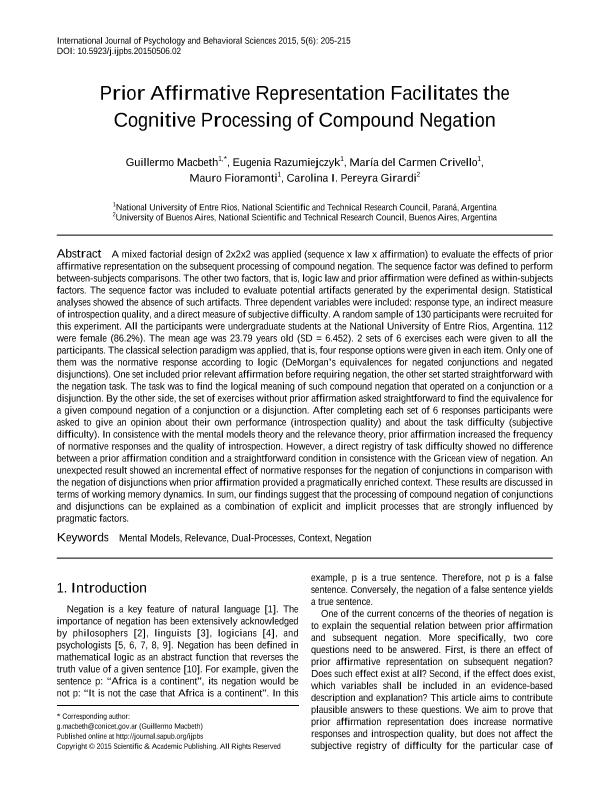Mostrar el registro sencillo del ítem
dc.contributor.author
Macbeth, Guillermo Eduardo

dc.contributor.author
Razumiejczyk, Eugenia

dc.contributor.author
Crivello, María del Carmen

dc.contributor.author
Fioramonti, Mauro Bruno

dc.contributor.author
Pereyra Girardi, Carolina Iris

dc.date.available
2021-02-12T17:12:23Z
dc.date.issued
2015-12
dc.identifier.citation
Macbeth, Guillermo Eduardo; Razumiejczyk, Eugenia; Crivello, María del Carmen; Fioramonti, Mauro Bruno; Pereyra Girardi, Carolina Iris; Prior Affirmative Representation Facilitates the Cognitive Processing of Compound Negation; Scientific & Academic Publishing; International Journal of Psychology and Behavioral Sciences; 5; 6; 12-2015; 205-215
dc.identifier.issn
2163-1946
dc.identifier.uri
http://hdl.handle.net/11336/125598
dc.description.abstract
A mixed factorial design of 2x2x2 was applied (sequence x law x affirmation) to evaluate the effects of prior affirmative representation on the subsequent processing of compound negation. The sequence factor was defined to perform between-subjects comparisons. The other two factors, that is, logic law and prior affirmation were defined as within-subjects factors. The sequence factor was included to evaluate potential artifacts generated by the experimental design. Statistical analyses showed the absence of such artifacts. Three dependent variables were included: response type, an indirect measure of introspection quality, and a direct measure of subjective difficulty. A random sample of 130 participants were recruited for this experiment. All the participants were undergraduate students at the National University of Entre Rios, Argentina. 112 were female (86.2%). The mean age was 23.79 years old (SD = 6.452). 2 sets of 6 exercises each were given to all the participants. The classical selection paradigm was applied, that is, four response options were given in each item. Only one of them was the normative response according to logic (DeMorgan?s equivalences for negated conjunctions and negated disjunctions). One set included prior relevant affirmation before requiring negation, the other set started straightforward with the negation task. The task was to find the logical meaning of such compound negation that operated on a conjunction or a disjunction. By the other side, the set of exercises without prior affirmation asked straightforward to find the equivalence for a given compound negation of a conjunction or a disjunction. After completing each set of 6 responses participants were asked to give an opinion about their own performance (introspection quality) and about the task difficulty (subjective difficulty). In consistence with the mental models theory and the relevance theory, prior affirmation increased the frequency of normative responses and the quality of introspection. However, a direct registry of task difficulty showed no difference between a prior affirmation condition and a straightforward condition in consistence with the Gricean view of negation. An unexpected result showed an incremental effect of normative responses for the negation of conjunctions in comparison with the negation of disjunctions when prior affirmation provided a pragmatically enriched context. These results are discussed in terms of working memory dynamics. In sum, our findings suggest that the processing of compound negation of conjunctions and disjunctions can be explained as a combination of explicit and implicit processes that are strongly influenced by pragmatic factors.
dc.format
application/pdf
dc.language.iso
eng
dc.publisher
Scientific & Academic Publishing
dc.rights
info:eu-repo/semantics/openAccess
dc.rights.uri
https://creativecommons.org/licenses/by/2.5/ar/
dc.subject
MENTAL MODELS
dc.subject
RELEVANCE
dc.subject
DUAL-PROCESSES
dc.subject
CONTEXT
dc.subject
NEGATION
dc.subject.classification
Psicología

dc.subject.classification
Psicología

dc.subject.classification
CIENCIAS SOCIALES

dc.title
Prior Affirmative Representation Facilitates the Cognitive Processing of Compound Negation
dc.type
info:eu-repo/semantics/article
dc.type
info:ar-repo/semantics/artículo
dc.type
info:eu-repo/semantics/publishedVersion
dc.date.updated
2020-09-08T19:52:52Z
dc.identifier.eissn
2163-1956
dc.journal.volume
5
dc.journal.number
6
dc.journal.pagination
205-215
dc.journal.pais
Estados Unidos

dc.description.fil
Fil: Macbeth, Guillermo Eduardo. Consejo Nacional de Investigaciones Científicas y Técnicas; Argentina. Universidad Nacional de Entre Ríos. Facultad de Ciencias de la Educación; Argentina
dc.description.fil
Fil: Razumiejczyk, Eugenia. Consejo Nacional de Investigaciones Científicas y Técnicas; Argentina. Universidad Nacional de Entre Ríos; Argentina
dc.description.fil
Fil: Crivello, María del Carmen. Consejo Nacional de Investigaciones Científicas y Técnicas; Argentina. Universidad Nacional de Entre Ríos; Argentina
dc.description.fil
Fil: Fioramonti, Mauro Bruno. Consejo Nacional de Investigaciones Científicas y Técnicas; Argentina. Universidad Nacional de Entre Ríos. Facultad de Ciencias de la Educación; Argentina
dc.description.fil
Fil: Pereyra Girardi, Carolina Iris. Consejo Nacional de Investigaciones Científicas y Técnicas. Oficina de Coordinación Administrativa Houssay. Instituto de Investigaciones Cardiológicas. Universidad de Buenos Aires. Facultad de Medicina. Instituto de Investigaciones Cardiológicas; Argentina
dc.journal.title
International Journal of Psychology and Behavioral Sciences
dc.relation.alternativeid
info:eu-repo/semantics/altIdentifier/doi/http://dx.doi.org/10.5923/j.ijpbs.20150506.02
dc.relation.alternativeid
info:eu-repo/semantics/altIdentifier/url/http://article.sapub.org/10.5923.j.ijpbs.20150506.02.html
Archivos asociados
